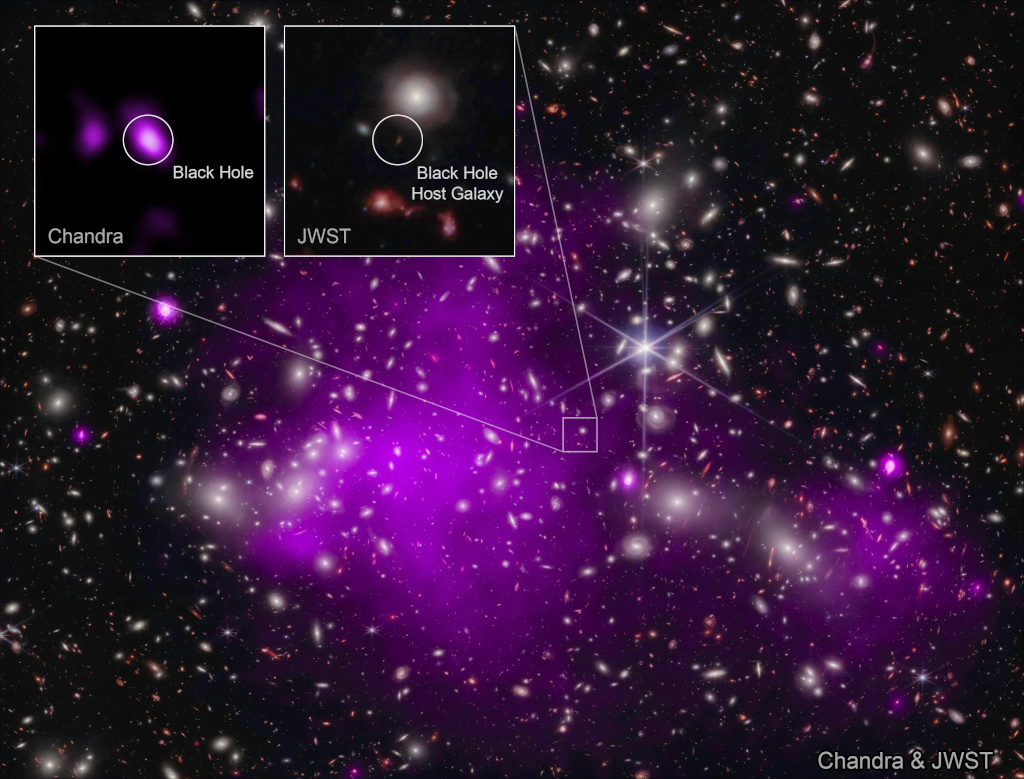2023年11月10日
UHZ1: Distant Galaxy and Black Hole
Image Credit: X-ray: NASA/CXC/SAO/Ákos Bogdán; Infrared: NASA/ESA/CSA/STScI;
Image Processing: NASA/CXC/SAO/L. Frattare & K. Arcand
Explanation: Dominated by dark matter, massive cluster of galaxies Abell 2744 is known to some as Pandora’s Cluster. It lies 3.5 billion light-years away toward the constellation Sculptor. Using the galaxy cluster’s enormous mass as a gravitational lens to warp spacetime and magnify even more distant objects directly behind it, astronomers have found a background galaxy, UHZ1, at a remarkable redshift of Z=10.1. That puts UHZ1 far beyond Abell 2744, at a distance of 13.2 billion light-years, seen when our universe was about 3 percent of its current age. UHZ1 is identified in the insets of this composited image combining X-rays (purple hues) from the spacebased Chandra X-ray Observatory and infrared light from the James Webb Space Telescope. The X-ray emission from UHZ1 detected in the Chandra data is the telltale signature of a growing supermassive black hole at the center of the ultra high redshift galaxy. That makes UHZ1’s growing black hole the most distant black hole ever detected in X-rays, a result that now hints at how and when the first supermassive black holes in the universe formed.
Tomorrow’s picture: light-weekend
UHZ1:遥远星系与黑洞
影像提供: X射线: NASA/CXC/SAO/Ákos Bogdán; 红外光: NASA/ESA/CSA/STScI;
影像处理: NASA/CXC/SAO/L. Frattare & K. Arcand
说明: 位在玉夫座方向35亿光年远处、主成分为暗物质的大质量星系团Abell 2744,有时亦有潘朵拉星团之称。最近天文学家利用此星系团的庞大质量作为重力透镜,扭曲时空并放大其后面更遥远的天体,从而发现了红移为Z=10.1的背景星系UHZ1。 UHZ1的距离为132亿光年,远在Abell 2744的后方,我们如今所见到的光影出发时,当时宇宙的年龄大约仅是目前的3%。在这张结合了钱德拉X射线天文台的X射线(紫)及韦伯太空望远镜红外光数据的组成影像里,UHZ1的身影出现在其中的嵌图之中。钱德拉数据所记录到的UHZ1之X射线辐射,是这个超高红移的星系中心,有不断成长的超大质量黑洞之迹证。这让UHZ1成长中的黑洞,成为在X射线波段侦测到的最遥远黑洞,这项成果也暗指宇宙第一个超质量黑洞是如何形成的及形成于何时。
明日的图片: light-weekend



